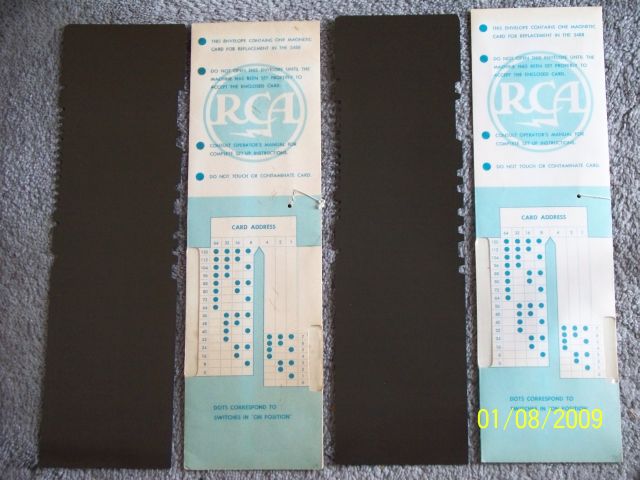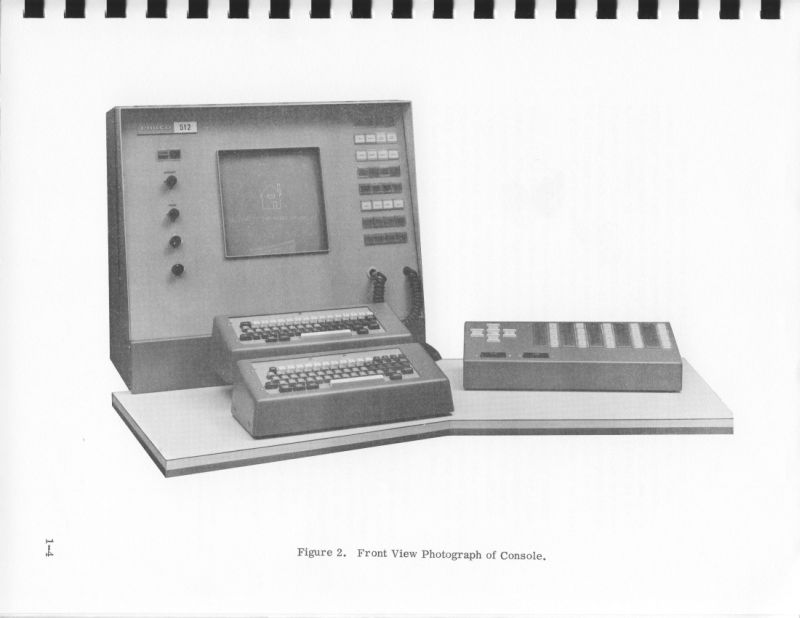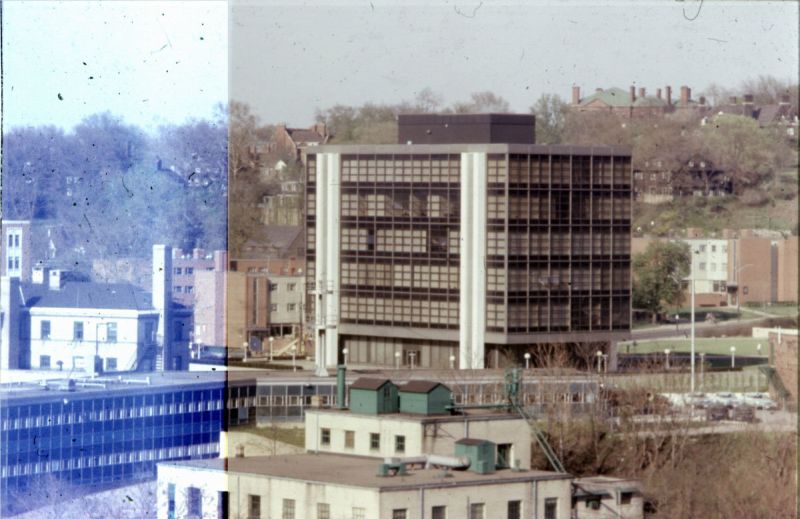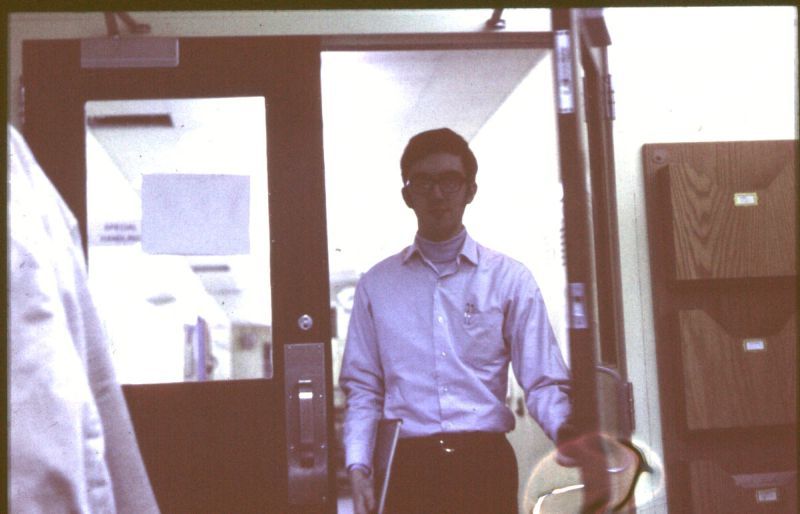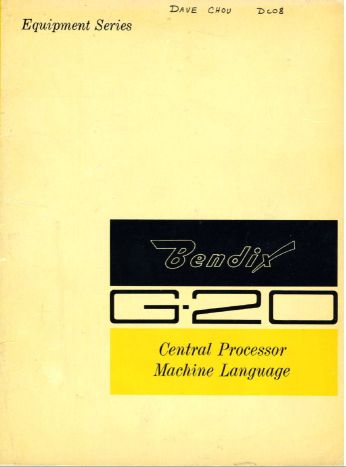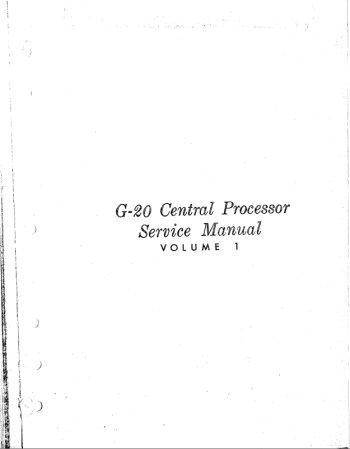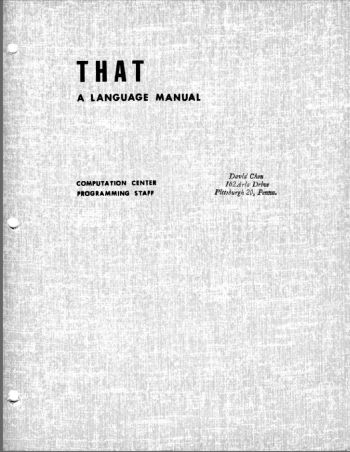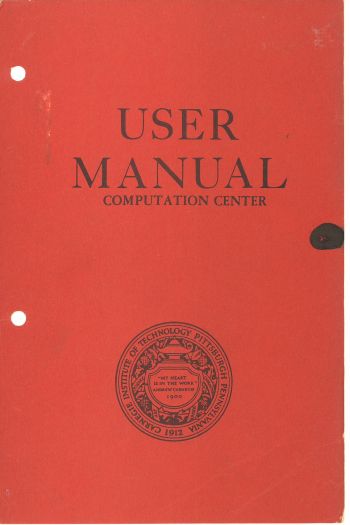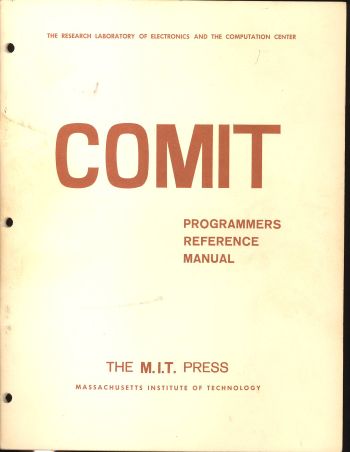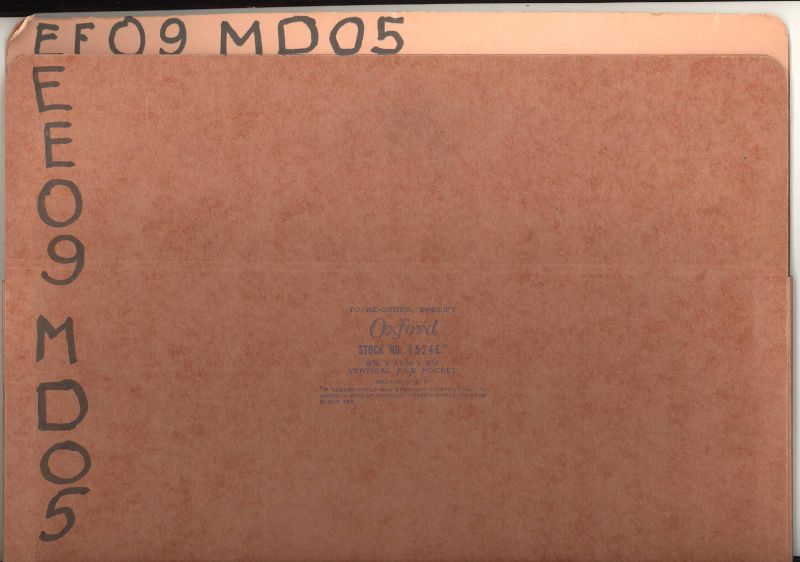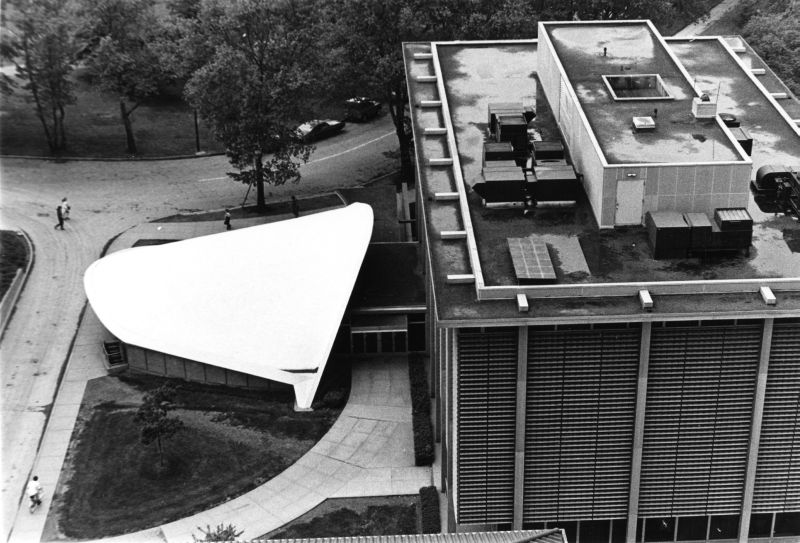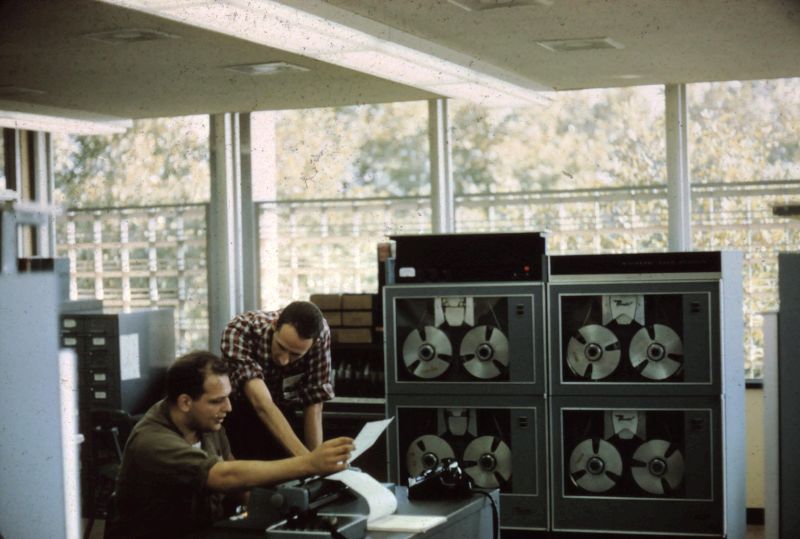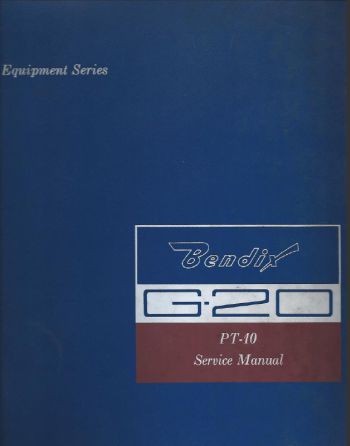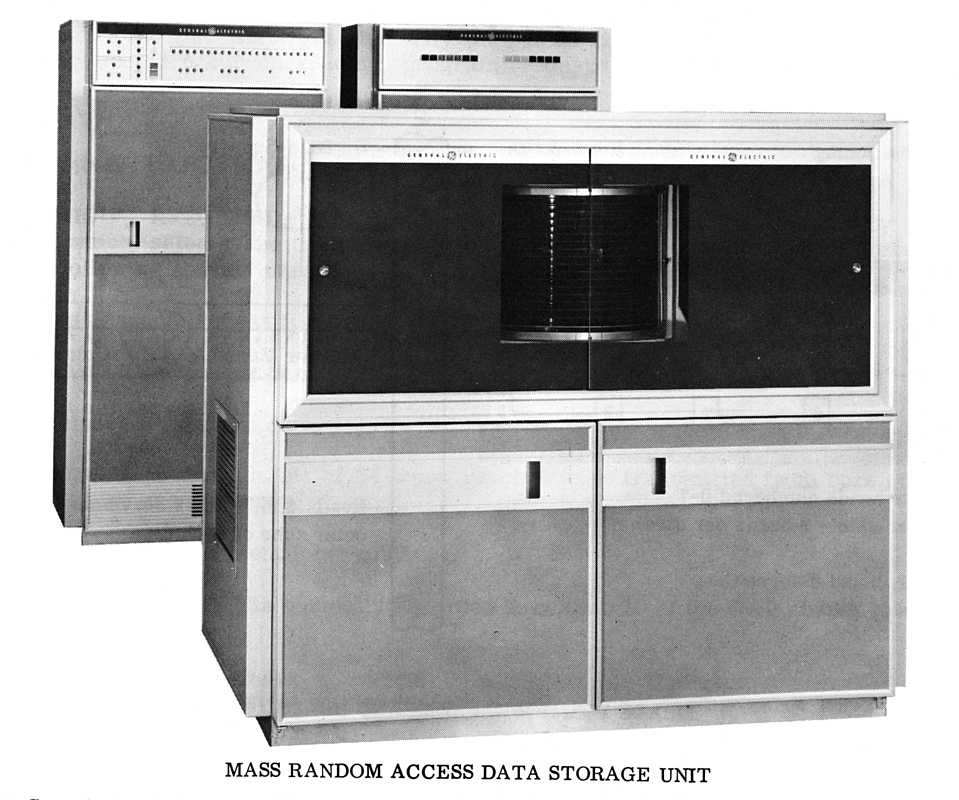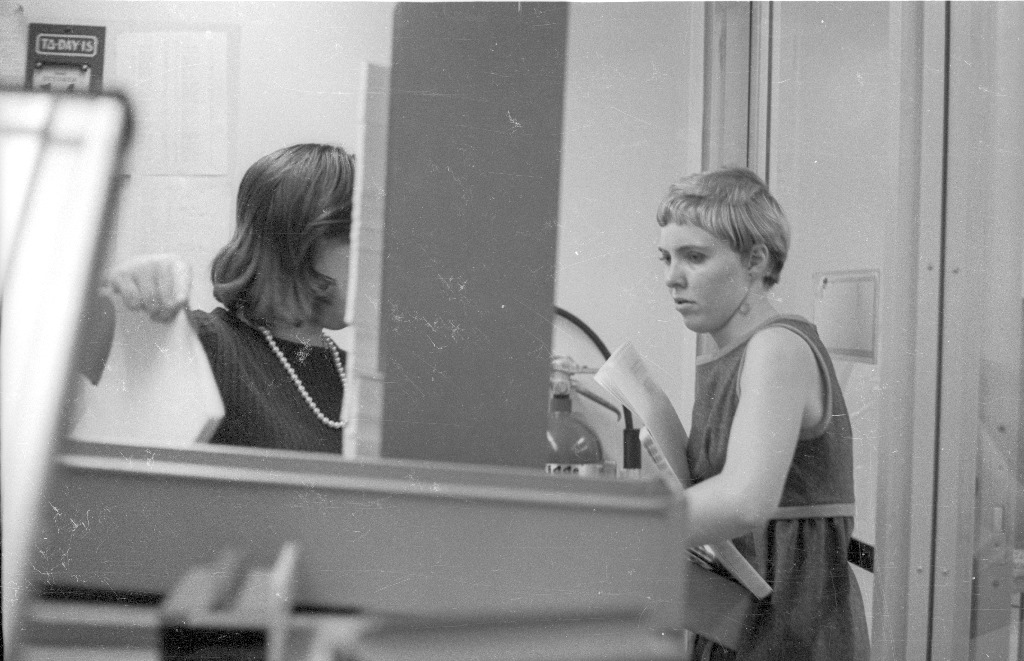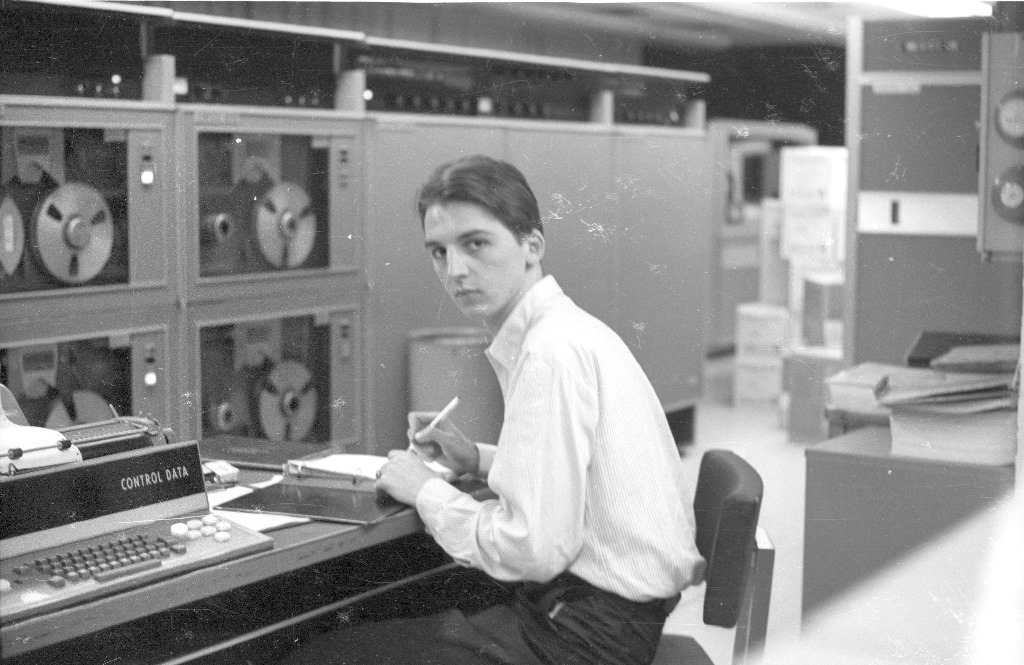Date: Mon, 2 Apr 2012 13:51:01 +0000 (UTC)
From: foxbw comcast.net comcast.net
Subject: RCA 3488 RACE
HI Mark,
I ran across your web site while googling the 3488 RACE machine.
In a past life I was a CSR (Computer Service Rep) for RCA Computer
Systems, 1968 - 1972, working mainly on the 3301 Realcom system.
I had the rather dubious privilege of maintaining two of those
devices. It was a sort of love / hate relationship; quite a
marvelous hydraulic / mechanic / electronic masterpiece of engineering
and a tempermental and frustrating beast at times.
I had to chuckle over the part of your site where the card being
ejected from the R/W head assy went sailing across the room to dent a
cabinet. One could do the same thing in a much safer manner by
loosening the tension screw on the single card extractor chute at the
rear of the machine. The correct tension would stop the card
right at the exit slot, but if you loosend the screw enough, it would
sail right through that slot at warp speed, pretty cool.
I kept my maintenance manual and one card when I left RCA (actually
UNIVAC as they had bought the firm) and still have it. It is
quite thick, 2/3 inches and weighs a few pounds. I would dearly
love to find some one who is trying to get one running again, and
either help or donate the book. I doubt if any exist.
BTW, they ran on RCA 301s, 3301s and also the Spectra 70 line, and RACE stood for Random Access Computer Equipment.
Regards,
Barry Fox
Sterling, MA |
Barry,
Thanks for your email. I forwarded it to our small group of 1960's techno nerds...
We may complain a lot about the RACE unit but back then it was a very
good way to keep offline storage that was still pretty fast to access.
Much better than magnetic tape. The RACE system was the backbone piece
of hardware that let us replace reading in boxes of punched cards with
program source on them.
May I use your email on my web page?
Mark |
Mark,
Yes, indeed, in its day it was the fastest way to retreive one record
out of a zillion without searching 2400 feet of mag tape. We kept the
entire state of Mass unemployment records on one and the other as a
backup. All day long people would go through the Division of
Employment Security remote sites to get their benefits. At the
end of the day, the tape that was used to record these transactions was
used to update the individual records on the RACE machine, using a
program called "DAMU", daily maintenance update". That ran the
RACE machine at full speed for 3 / 4 hours straight, usually resulting
in some spectacular card jams.
Sure, you can put my ramblings on your web page.
Barry |
|
Hi
Barry,
Mark forwarded your email to the Athena Group. I enjoyed reading your
experiences with it. I never had a bad experience with the extractor chute, the
card would always just stick out about an inch or so. When this would happen I
would examine the card and if one of the fingers wasn't completely broken off
(just folded over) I would "fix" it and stick it back in another slot which ran
the card down the front of the drive and wrapped it around the read drum, then
shot it back down the back of the drive and filed it back in it's proper place
(usually ;-). Of course this was just delaying the inevitable :-) Again I
believe the RACE drives I "operated" in spring 68 were not the first at the site
as there was a deflector arm on the read head assembly which snagged the card as
it came out of the box and directed it into the drum. As I recall the head
assembly was held in by a single (or maybe it was two) jackscrew and loosening
that tripped an interlock which prevented the drive from selecting a card. The
earlier drives had this deflector as part of the plexiglass cover and opening
that did not trigger the interlock (as it didn't with the units I serviced as
well). I had to remove the head assembly once a shift in my job as part time
computer operator to clean the drum with alcohol. Of course I also always
remembered to first go over to the 301 and halt it :-)
I also don't believe that the units I used were the last design for the
drives as some advertising I think Mark's site points to shows that the bins
containing the cards were user removable. They were not on the units I serviced.
This might have been an advancement to compete with the IBM Datacell which did
have removable bins (I've got a couple :-) One funny story you might appreciate.
The service engineers who maintained our RACE and the G-20 processors worked for
Philco. One of them once told me that he took failed RACE cards and used them as
hinges for his dog door as they were made of relatively stern plastic. They are
a lot more rugged than the Datacell cards, the plastic is thicker. I assume you
saw the photo of the two RACE cards I have on Mark's site. If you have any
further information about the RACE, in particular details about the various
versions of the drives, I, at least, would certainly like to hear about them.
Despite it's problems, it successfully provided the major on-line storage for
CIT's main computer system for a number of years. It was certainly more reliable
than the Datacell.
73, Chris Hausler
|
From: "Dave Chou" <dchou uw.edu> uw.edu>
Subject: RE: (Fwd) RCA 3488 RACE
Date: Mon, 2 Apr 2012 08:55:22 -0700
Wow - this is fantastic.
As a G21 operator, I somehow earned the dubious privilege of doing the
monthly backups on the RACE units on third shift. Most of the
time, I could take a snooze, but when the monthly backups occurred, it
was a constant marching between the RACE unit, the 301 console, and the
G21. I am not sure I would want to put the card into service -
too many cards ended up as an accordion during the backup.
Dave |
|
From: foxbw comcast.net comcast.net
Sent: Apr 8, 2012 2:56 PM
To: Dave Chou
Cc:
Mark DiVecchio , Bob McFarland , Charlie Putney , Dale Dewey , Dave Rodgers ,
Dave Vavra , David Chou , Glenn Sembroski , "J. Chris Hausler" , James Pollock ,
John Yurkon , Lauston Stephens , Patrick Stakem , Roy Engehausen , Russ Moore ,
Tom Engelsiepen
Subject: Re: (Fwd) RCA 3488 RACE
Hi Guys,
Wow, had no idea there were so many RACE machine people out there.
I dug through the manual and found some specs for those who are interested:
7 bits per character
650 characters per block
166,400 characters per card
256 cards per magazine
42,598,400 characters per magazine
8 magazines per 3488-1
340,787,200 characters per 3488-1 (minimum system)
16 magazines per 3488-1 / 3488-2 (-2 is expansion unit)
681,574,400 characters per 3488-1 / 3488-2
5,482,595,200 characters per 8 3488-1 / 3488-2 (maximum system)
system architecture:
301 or 3301 processor connected to:
380 or 3388 RACE control module
one control module for from 1 to 4 RACE machines
so max system is 3301 / 2X3388 / 8X3488 each 3488-1 with an expansion unit (-2)
All of our machines had the removable magazines and its related magazine loading guide
We ran these things hard all day on the day shift and spent at least 2
hours each during 4-12 shift doing PM, replacing bearings (lots of
those) pinch rollers (ditto) and running diagnostics. We cleaned the
R/W drum with liquid Freon, had a 5 gallon can of the stuff in the
shop. Neat stuff, would boil in your hand, OSHA would have a fit today.
If I haven't bored you too much and have any detailed questions, fire away.
Cheers,
Barry
|
|
Hi
Barry,
Your data shows
256 cards per magazine. Looking at a card or the envelope which held the new
cards (see photo on web site), the physical card address represented by the
fingers on the sides of a card is only 7 bits, enough to address only 128
separate cards. It was my understanding that the unique fingers on each card was
what allowed its selection out of a specific magazine (or bin as I recall them
being called). This seems to imply that each magazine might have had two
separate compartments. In fact a very fuzzy memory of mine is that the "bins" in
the units at CIT/CMU might have had a dividing partition in each. Can you
confirm or deny that the magazines on the units with which you worked had two
separate compartments?
73, Chris
Hausler
|
My recollection was that there was a
single aluminum carrier which held the cards stacked side by side that
was removable by an operator. This carrier was about 4 inches in
width, but I don’t know if a “set” consisted of one
or two carriers. I don’t think that 250 cards would have
fit into a single carrier, so this impression is consistent with
Chris’s comments that a magazine held 128 cards (or often less,
because midnight operators didn’t replace cards that were
damaged).
Dave |
From: foxbw comcast.net comcast.net
Sent: Apr 8, 2012 11:03 PM
To: "J. Chris Hausler"
Subject: Re: (Fwd) RCA 3488 RACE
Chris, et al,
Roger that, each magazine had two halves, 128 cards each
A combination of push up bars, push down bars and the addressable teeth
of the gripper assembly managed to select one of 128 cards, from one
side of the mag or the other. Very complicated mechanical mechanism
driven by simple discrete transistor logic circuits.
Each card has 4 sets of notches / tabs, labeled A, B, C and D.
The A set are on the bottom edge between the two labeled E and F, to be explained later
The B and C set run together on the right hand two thirds of the top of the card
the D set are on left hand third top of the card
Quotes from the theory of operation:
"Each magazine contains 256 cards, physically separated into two packs
of 128 cards each. Each card is notched according to an address code
determined by the 7-bit card address. It is this notch pattern that
defines a card within the pack rather than its location with respect to
the other cards.
Set A notches
The bottom edge set A notches are derived from the four
most-significant bits of the 7-bit card address. Set A contains 16
notch positions, one for each of the 16 possible binary combinations of
these four bits. The position corresponding to the card address is not
notched, while the other 15 positions are notched.
Set B notches
The top edge set B notches are derived from the same four
most-signifcant bits of the card address as the Set A notches. Set B
contains 8 notch positions, a 1 and a 0 position for each of the four
bits. The set B notch positions are notched in binary fashion,
corresponding to the card address. The A and B sets of notches break
down the 128 card pack into 16 8-card groups.
Set C notches
The top edge set C notches are derived from the least-significant bits
of the card address. Set C contains 6 notch positions, and is notched
in binary fashion, corresponding to the card address.
Set D notches
The top edge set D notches are derived from the same three
least-significant bits of the card address as the set C notches. Set D
contains 8 notch positions, one for each of the 8 possible binary
combinations of the three bits. The entire set D area is cut away
except for the notch position corresponding to the binary combinations.
The uncut position is termed a tab. The C and D sets of notches break
down an 8-card group into individual cards.
The bottom E notch (closest to the front ahead of the A set) is always
located at this position on the card. It is used with a guide bar to
properly position the card in the magazine.
The bottom F notch (closest to the rear behind the A set) is always
located at this position on the card. In conjunction with the other
bottom edge notches, it is used in the development of the block index
signals by the photocells located at the capstan.
If you all are not bored to tears yet, I can describe the sequence
step-by-step on how the mechanical system utilizes these tab / notches
to grab just one card out of a magazine of 256 and send it to the R/W
capstan. Any takers?
73 (guess there are some hams out there)
Barry - W1HFN |
Hi Barry,
Good Stuff!! Keep it coming.
Yes, I'm a Ham but not an active one, call WB2TLL. My interest in the
telegraph these days is land line American Morse telegraph. I collect
the instruments (There is a photo on the site under "CMU photos from
Chris Hausler" part way down which shows a bunch of telegraph sounders
in resonators taken in my "family room", not at CMU :-) with well over
a hundred in the collection at the moment. If you are interested there
is a group, the Morse Telegraph Club, founded in 1942 of which I am an
active member, see http://www.morsetelegraphclub.org/ and we also now
have an Internet telegraph system (replacing all those pole line wires
:-) free to download at: http://home.comcast.net/~morsekob/ . (Using
this program there's a telegraph sounder clicking away next to my
computer connected to wire 121 with today's news headlines at 20 WPM
from a Yahoo RSS feed as I write this :-)
We also celebrate Morse's birthday each year on "Morse Day", the last
Saturday of April (he was born the 27th) and I will traveling (taking
Amtrak) down to VA and joining with MTC's "Washington-Baltimore"
chapter at the Railway Mail Service Library in Boyce, VA for that
event. I will also be driving out to Dayton, OH for the big annual
"Hamvention" in May, to help man an MTC booth (right next to
Vibroplex's booth :-) I don't know whether you attend this but if you
do, please stop by and say hello! I believe Mark is a ham too.
73, Chris Hausler |
From: foxbw comcast.net comcast.net
Sent: Apr 9, 2012 10:44 PM
To: jchausler earthlink.net earthlink.net
Subject: 3488 card select
Hi Chris,
I think it would be better if I just sent this stuff to you and you can decide whether or not to forward it.
Very interesting your landline Morse interest. I could never figure out
how clickey-clacks could be interpreted, while dits and dahs were easy
for my mind to grasp. BTW, the local art museum has one of SFB Morse's
paintings displayed prominantly.
http://www.worcesterart.org/Collection/American/1907.35.html
I have been licensed over 50 years now, operate from 160 through
900MHz, actually have my own 900MHz repeater on a local hilltop. Main
interests are RTTY, antenna experimentation and fox hunting.
3488 Card Select Sequence:
Preface: there were two kinds of card extraction grippers, the
"clapper" and the "scissors" type. The only ones I am familiar with are
the clappers, so the sequence will refer to that type. They are quite
different in appearance and function and pretty difficult to describe
in text. I do have a scanner, so if someone wants, I can scan the
different images. BOTOH, I doubt if anyone has a RACE machine in their
basement with which to compare the pics ;>)
The card selection and extraction process goes through 9 steps,
controlled by 4 flip-flops, STA, STB, STC and STD. They are sequenced
such that some are set while the others are reset, i.e.: 1=set, 0=reset.
STA STB STC STD
Step 1 1 0 0 0
Step 2 1 0 0 1
Step3 1 0 1 1
Step4 1 0 1 0
Step5 1 1 1 0
Step6 0 1 1 0
Step7 0 1 0 0
Step8 0 1 0 1
Step9 0 0 0 0
that may be more than anyone wants to know, but it is interesting, at
least to me, how such a complicated sequential mechanism could be
controlled with only 4 FFs
Step 1 - a. the selected bail assembly is activated b. the gripper
knuckle is enerized c. the selected mag extracton pinch roller is
activated for "pre-spin" to speed extracton d. the upper bar assembly
pushes down all cards
Step2 - the lower bars to select the card are pushed up
Step3 - a. the pinch roller pre-spin is de-activated b. the lower gripper comb is activated c. the gripper assembly is lowered
BTW, all of these mechanical activations are verified by micro-switches
which feed the logic matrix, thereby advancing the steps (or setting
error bits if not true)
Step4 - a. deactivate holddown bars and lower bars b. lower the pushdown bars
Step5 - a. deactivate pushdown bars and bail assembly b. raise upper bars
Step6 - a. move gripper assembly forward (it has one card gripped in the teeth of its comb)
Step7 - a. open gripper jaws b. raise gripper assembly
Step8 - a.move gripper assembly rearward b. close pinch rollers to pull card into raceway and thence to the R/W capstan
Step9 - reset ABC&D FF to 0
Had enough? There's lots more
73, Barry - W1HFN
|
Hi Barry,
Yes, please go on! Understand you may be the only remaining repository
of this information. So getting it out there on the web on Mark's page
may be the only real way of preserving it "for the ages". I have been
recently reviewing the pages maintained by several members of an east
coast "retro computing" group. One has an interesting history of
magnetic media storage but completely misses the card media units of
the 60's (the RACE, the NCR CRAM and the IBM Datacell, at least those
are the ones of which I am aware). There is a lot of data out there
already on the IBM Datacell and I've even found some data on the NCR
CRAM but almost nothing on the RCA RACE. BTW there was a rumor that
both the RACE and the CRAM were designed by the same principal engineer
but I've never been able to verify this (in fact the rumor went on to
say a third card memory system was designed by this man (but not the
Datacell) but I've never found reference to any such thing. My only
exposure to a CRAM was that it was the centerpiece of the NCR exhibit
pavilion at the 1964-65 NY Worlds Fair. CIT (CMU) did also have a
Datacell connected to their IBM 360/67 for a while in the late 60's but
it didn't last long. I have couple of the cells from it (found in a
dumpster when visiting the campus in 1976). Of course the big problem
with all of these devices is that they traded complexity for storage
capacity when compared to contemporary disk systems (from research it
looks to me that they were capable of roughly an order of magnitude
more storage than contemporary disk systems but disk technology and
storage density advanced so quickly that the more mechanically complex
card memory systems were quickly overtaken). Anyway, so photos, scans
of manuals and all would be welcome!
As to understanding Morse Code on a sounder, it's just another sound.
Each letter has a unique sound to it just like with tones and you learn
the sound of the letters and sometimes whole words. If you try and
follow the dots and dashes with either code, you're doomed to begin
with ;-) I'm not all that good with either code. From what I've found
with American Morse on sounders is you really have to start at a speed
of at least 15 to 20 WPM and then add in a fair amount of Farnsworth
between the individual letters. This helps you learn the sounds of each
letter rather than paying attention to the individual clicks. That free
to download MorseKOB program will allow you to set up some delay
between letters when told to read from a local text file and can also
mix tones with clicks to help you transition to clicks. Of course, it
uses American Morse instead of International Morse but after all 15 of
the letters are the same in both. Although connecting real telegraph
instruments to you computer is a lot more fun, the program will
generate the clicks quite well using the computer's sound system and
the PC only version (2.5) allows you to select a range of different
sounding clicks to boot. You might want to try it just for fun. You can
read all about it on the program's web site.
There's also a couple Yahoo groups for land line telegraphy. The main
one is "slowspeedwire" and there's one specifically for the MorseKOB
program called "MorseKOB" of course :-) (Just in case you're interested
;-)
Thanks for the link to the Morse painting, I'm going to pass it along
on slowspeedwire. He was quite a skilled painter (and writer as well)
and his paintings are quite prized today.
My ham experience has been rather checkered. I was briefly active in
the early 1960's but that was about it. The license I currently have I
got in the mid 1970's and have never used it. I have been a member of
the local ham radio group for decades. It was at the local hamfest flea
market (once quite large, as big as Dayton is today) about 15 years ago
that I found and purchased a telegraph sounder which started me down
this "land line" path although at the time I was looking for old
computer stuff rather than radio stuff. Maybe one of these days...
I will forward all this to Mark as well
73, Chris Hausler
|
|
Hi
Mark,
Barry has sent
me more RACE stuff, including two photos of, if I understand correctly, two
different designs used for selecting cards. If for some reason they don't go
through, let me know and I will send them separately as I have saved the images.
I will also copy you on my response to him thanking him (and asking for more
:-).
73, Chris
Hausler
|
|
(click on image for full size version)
Hi,
The two images of the clapper and scissors gripper are attached. As stated earlier, the clapper gripper version is the
only one I ever worked on.


The 3488 saga continues:
The card has been extracted from its’ magazine and sits between the pinch rollers. And we quote:
“Before the card can
be extracted, it must be determined that the capstan does not have a
card on it. When the capstan is ready and the previous card had
not left because of 32 unserviced revolutions, the activate pinch
roller signal (APR) is generated to extract the card and place it on
the capstan.
When the card enters the
transport, its position is sensed by a photocell. As a result, a
card in transport signal (CIT) in generated which provides a signal to
load the active register. Thus the active register contains the
address of the desired card. This address is compared with the
address of the extracted card as determined by photocells in the read /
write station entry track. When this comparison verifies the
address of the extracted card, the recirculate gate is closed and the
read or write operations can be performed.
Should an incorrect card be
extracted, the address comparison will detect it, at 3he re76ciadjfl
(cat just walked on the kbd, sorry) the recirculate gate will remain
open, and an error indication will occur. The incorrect card
will pass around the read/write station and be returned to its
magazine. “
Read / Write
“As the card revolves
on the capstan under the recording heads, the card position is
monitored by two sets of photo-transistors. These sensors detect the
address code contained in the notches along the lower edge of the card,
and determine which block on the card is under or approaching the
read/write heads. The block index signals enable the quadrant
decoding matrix. The matrix generates these control signals to
the control module: pre-begin read/write, block approach
detected, begin read/ write, and next block pulse. In the
control module, these signals determine the time at which data transfer
begins to the storage unit.
When the block address of a
card on the capstan is changed, the head register is compared with the
new address to determine if a head position is required. If the
head position requires changing, the head register check flip-flop will
remain set allowing the head change enable flip-flop to be set.
The new head position data is loaded into the head register and the
transfer of control signals from the quadrant decoding matrix is
inhibited for two consecutive index pulses. This allows the head
positioner to move the heads to the new position and prevents the
transfer of erroneous control data to the control module during the
transient period.”
I wish the manual had a
detailed explanation of the head position sequence, but it does
not. It was quite a kludge (as was quite a bit of the machine)
using hydraulics to move the heads up and down (and the gripper
assembly back and forth) and a very rudimentary binary sensor to
determine where the head was. The hydraulic unit was in a slide
out drawer under the capstan assembly, and if memory serves, there was
always a puddle of hydraulic fluid on the floor there. Of course
it was a British unit, made by Vickers, so that explains the
leaks. I can say that, having owned several British sport cars
"back in the day".
Thanks for all the info on
the landline Morse. I will take a look at the site you mentioned
and see if I can get my ears around it.
73,
Barry
|
Hi Barry,
Once again thanks!! Keep it
coming. I have forwarded the information and photos to Mark. One
wonders where all the mechanical engineers who designed these things
have gone. From my perspective, computers just aren't "fun" anymore,
hydraulic oil and all ;-)
On the Morse Telegraph
front, Saturday, April 28th, is the annual celebration of "Morse Day"
by the Morse Telegraph Club (Morse was born on the 27th but we always
celebrate it on the last Saturday of April). If you download the
MorseKOB program or just run the Java version (3.0), there should be a
bunch of folks on wire 11 for several hours likely mid day (eastern or
central time, I haven't heard from any west coast chapters) that day.
I'm going down to the Railway Mail Service Library in Boyce, VA and
gathering with several folks and we will certainly be on the wire. I
know at least three or four chapters from around the country will be
having events and in addition, a number of individuals will be on too.
Remember, you don't need any real instruments, the sounder clicks will
be generated by the computer's sound system. The PC only version (2.5)
has several different selectable sounder "sounds". With this you can
listen in on the activity. Just FYI...
73, Chris Hausler
|
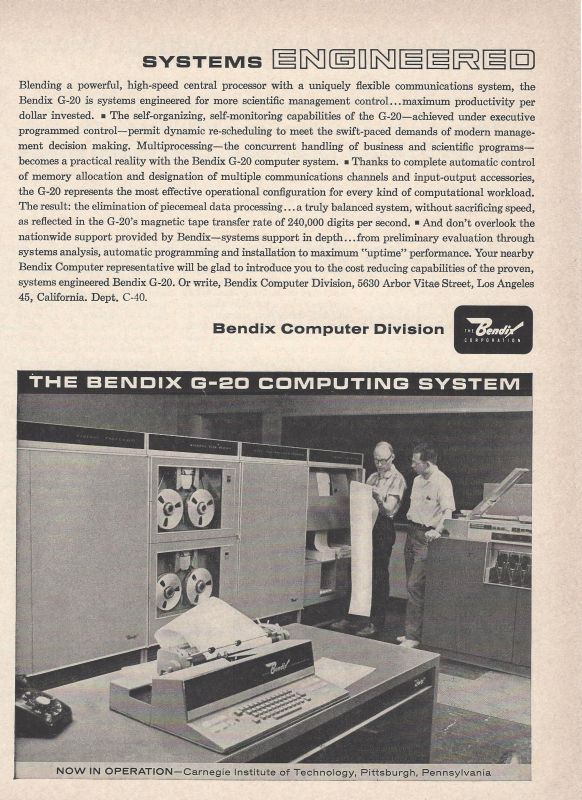
 The two men in this ad might be Hal van Zoeren and Carl Lefkowitz.
The two men in this ad might be Hal van Zoeren and Carl Lefkowitz. sprynet.com>
sprynet.com> earthlink.net>
earthlink.net> gmail.com
in case you want to contact him :-) and living in Cupertino, CA.
The advertisement was likely from circa 1961 and the color photo a few
years later. The listing for Dr. Jim McElroy says he graduated
from CIT in 1965 but his address is shown as "unknown" and so there is
no further detail about him or his degree. I checked my 1997
directory and likewise his address is unknown in that one too.
But the graduation date would at least indicate to me that he was a
younger man.
gmail.com
in case you want to contact him :-) and living in Cupertino, CA.
The advertisement was likely from circa 1961 and the color photo a few
years later. The listing for Dr. Jim McElroy says he graduated
from CIT in 1965 but his address is shown as "unknown" and so there is
no further detail about him or his degree. I checked my 1997
directory and likewise his address is unknown in that one too.
But the graduation date would at least indicate to me that he was a
younger man. gmail.com>
gmail.com>